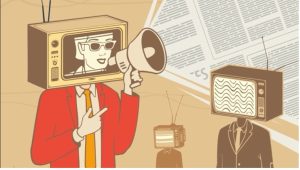Propaganda: The language of systemic influence
21 What to do about propaganda?
Detection
With the rise of especially gray and white propaganda, the detection of propaganda becomes especially difficult. These two types of propaganda are seen mainly through the use of social media platforms in recent times, which has made it much more difficult for the average audience of social media users to distinguish between propaganda, or just simple persuasion in the form of PR. Considering the fact that there is an increasing amount of propaganda on the internet, it harms the users because it has made simple information less accessible as propaganda and persuasion have become heavily intertwined, though they should not be. The overall importance of distinguishing the two has been placed on the sources of the information as well as the contexts in which they are posted.
Lock, I., & Ludolph, R. (2020). Organizational propaganda on the Internet: A systematic review. Public Relations Inquiry, 9(1), 103-127. https://doi.org/10.1177/2046147X19870844
After defining propaganda, it is next important to determine how to detect propaganda in its many different forms. This task is not simple because of the ideological nature of propaganda which attempts to change or reinforce particular narratives within individuals. Ellul (1973) explains how obvious facts contribute to the overall successful of propaganda, especially during wartime, further suggesting that ‘propaganda’s content increasingly resembles information’ (Zollmann, 2019, p. 340). This means that it is also increasingly difficult to detect information if more things are presenting themselves as factual evidence. This poses a difficult challenge for individuals, especially those who regularly engage with media, to determine which types of content are propaganda.

Kirill et al. (2020) develop a framework for identifying propaganda through the use of topic modeling. They conclude by stating how propaganda is actually quite difficult to detect, both for complex automatic models and experts alike. Elder (2018) defines key features of propaganda including the presence of false or misleading information, manipulation using unfair means, attempting to necessitate a mass audience, serving propagandistic interests, disseminating information systematically, and concealing information which would aid in properly evaluating the content. These key features can act as a checklist for detecting propaganda, if a text contains each of these themes it is more than likely to be propagandandistic. Additionally, Zollmann (2019) attempts to define propaganda through a synthesis of definitions created by other authors, stating that propaganda is “the forming of texts and opinions in support of particular interests and through media and non-media mediated means with the intention to produce public support and/or relevant action” (p. 335). Although propaganda may be difficult to detect, these key definitions are certainly a starting point to understanding the nature of propaganda and how it is meant to serve certain interests by shaping public opinion.
[RL]
References
Elder, Katherine A. (2018) “Propaganda for Kids: Comparing IS-Produced Propaganda to
Depictions of Propaganda in The Hunger Games and Harry Potter Film
Series.” International Journal of Communication 12, 909–927.
Kirill, Y., Mihail, I. G., Sanzhar, M., Rustam, M., Olga, F., & Ravil, M. (2020). Propaganda
Identification Using Topic Modelling. 9TH INTERNATIONAL YOUNG SCIENTISTS
CONFERENCE IN COMPUTATIONAL SCIENCE, YSC2020, 178, 205–212. https://doi.org/10.1016/j.procs.2020.11.022
Zollmann, F. (2019). Bringing Propaganda Back into News Media Studies. Critical Sociology,
45(3), 329–345. https://doi.org/10.1177/0896920517731134
https://journals.sagepub.com/doi/full/10.1177/0896920517731134
Resistance
more blah

Feedback/Errata